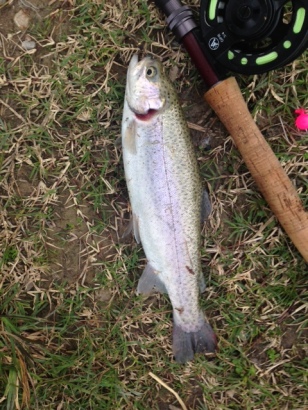I have taken the last couple days and started thinking about this coming year and what I want to accomplish on the water.
First and foremost I have decided I want to be a little more active on the water. By that I mean I want to be able to go fishing more. A good way for me to come up with fresh topics for this column is to actually get out on the water with my fly rods and just try new things. By doing this I will find new flies, flies that work on the species we target here on the Northshore other than bluegill. I have a good handle on catching bluegill on the fly rod. That new job I took in October has given me the means to have more time on the water. I have every weekend off now and will be working fewer hours which means I might be able to get out on the waters closer to my house in the evenings.
Another thing I want to work on this year is figuring out how to catch bass on the fly. This one might take more than a year. In order for me to figure out bass on the fly, I need to become a better bass fisherman in general. When I was a kid and teenager I did a good bit of bass fishing with my dad. My dad was kind of stuck in his ways when it came to bass fishing. He used a texas rigged worm just about all the time. This kind of stunted my growth as a bass fisherman. We also fished the same spots every trip because we fished the same body of water every trip. While this makes me a great bass fisherman in Lac Des Allemands and Bayou Des Allemands, it doesn’t help me find bass on the rivers and bayous of the Northshore. For the past couple years, I have been fumbling around Bayou Lacombe and Bayou Cane and stumbling on stringers of fish. The main reason I started looking for a new kayak last year was that I wanted a depth finder. My old kayak just wasn’t suited one. I have been watching some videos on Youtube from people like Gene Jensen, Flukemaster, to learn a little bit more on how to find bass. One of the things I have taken away from his videos and emails with him is the use of a depth finder to locate structure and cover that hold fish. I have installed a unit on my kayak now and it should help me find fish quicker than I have. To bring this back to fly fishing, this will allow me to present flies to these fish as well as conventional lures.
A third thing I want to work on is making more informational videos on my YouTube channel. This past year I would just make videos when I would catch fish on my trips. While this will continue, I want to start incorporating my own voice to the videos rather than just a music bed under the video.
Something else I plan to work on is exploring new waters. Since I began fishing the Northshore in 2012, I have only fished a handful areas: the rigolets, the trestles, Bayou Liberty, Bayou Lacombe, and Bayou Cane. This year I want to get out and learn new areas such as the Rice Field Canal and the Tchefuncte. I am open to suggestions, just send me a message on the forums and I’ll do my best to get out there.
One other thing I want to do this year is fish some tournaments from my kayak. The ATAK is much more suited for tournament fishing than the Sundolphin was. For the past couple years, I’ve wanted to fish Ride the Bull, but was worried about getting out there in that little sit-in. It was kind of tippy and cramped. Since I couldn’t stand up in it, my back, hips, knees, and butt would start to hurt after a couple hours. All that has changed now that I can stand. Another problem I had with fishing tournaments was they all happen in places I’ve never fished. I didn’t want to get out there and not venture far from my launch site for fear of getting lost. The depth finder/gps I installed will help me return safely. I’m also thinking of working with a business on the north shore of Lake Pontchartrain to get a series of kayak tournaments there. I would much rather drive an hour to an hour and a half to fish a tournament rather than two and a half to three hours to Grand Isle or Venice.
That just about covers what I want to do this year. I hope it all pans out and hope to see you guys and gals out on the water. Tight lines!
JZ
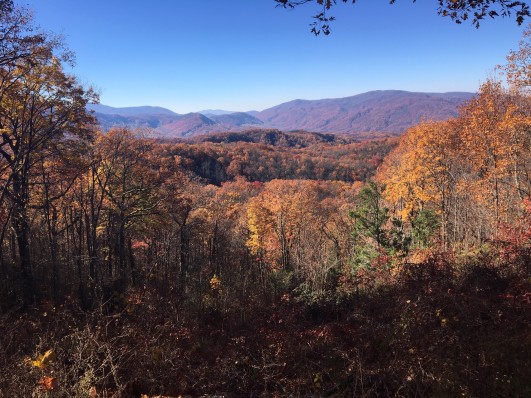
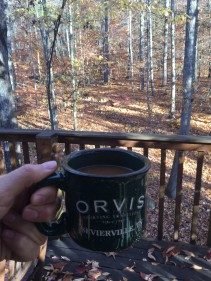


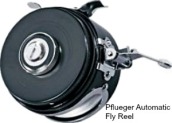 spring will release its tension and the line will be re-spooled into the reel. This is a great reel to have if you have mobility issues in your hands; however, for the day to day fly angler I wouldn’t recommend one. They are relatively heavy and throw your rig off balance. Also, the spring can release its tension if the reel is dropped or if you accidentally hit the lever.
spring will release its tension and the line will be re-spooled into the reel. This is a great reel to have if you have mobility issues in your hands; however, for the day to day fly angler I wouldn’t recommend one. They are relatively heavy and throw your rig off balance. Also, the spring can release its tension if the reel is dropped or if you accidentally hit the lever. 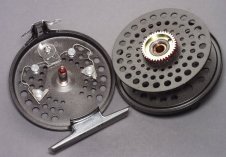
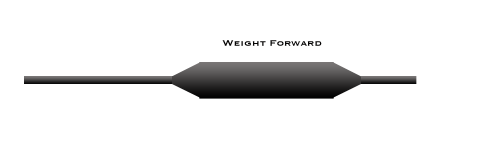


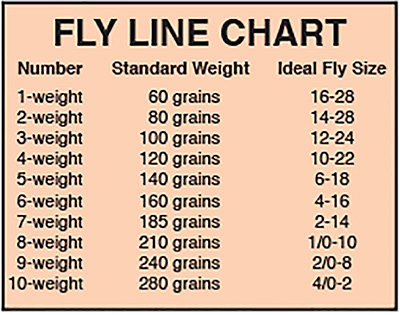
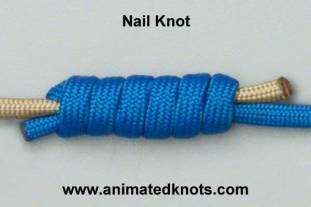
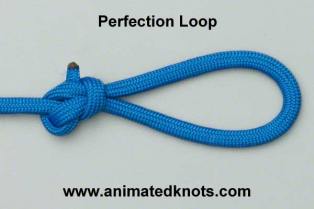
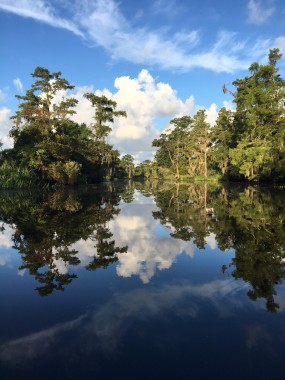
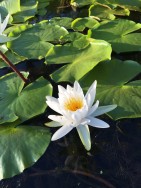 wacky rigging. After unloading I was paddling down the bayou about 6:20. I started fishing at my normal spot, just behind Justin Wilson’s estate. Just like most trips, a fish was there. However, I missed it. After fishing there for a few more minutes I headed down stopping here and there with no bites. After seeing a good bit of surface activity I decided to pick up the 4 wt fly rod and throw a popping bug. After a few casts with no takers, I put it down and continued down Cane. I fished here and there throwing at every tree, lay down, and stump with no hits. It wasn’t until I got to what I call the Touchdown cut before I got a good solid hit. I set the hook and pulled in my first keeper bass of the day. By the time I got it in the yak and unhooked, the wind and current had pushed me on top of where I caught the fish. At that point, I decided to let the current and breeze push me down the bayou all the
wacky rigging. After unloading I was paddling down the bayou about 6:20. I started fishing at my normal spot, just behind Justin Wilson’s estate. Just like most trips, a fish was there. However, I missed it. After fishing there for a few more minutes I headed down stopping here and there with no bites. After seeing a good bit of surface activity I decided to pick up the 4 wt fly rod and throw a popping bug. After a few casts with no takers, I put it down and continued down Cane. I fished here and there throwing at every tree, lay down, and stump with no hits. It wasn’t until I got to what I call the Touchdown cut before I got a good solid hit. I set the hook and pulled in my first keeper bass of the day. By the time I got it in the yak and unhooked, the wind and current had pushed me on top of where I caught the fish. At that point, I decided to let the current and breeze push me down the bayou all the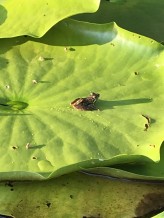 way down Cane to the lake. On my way down I only picked up a couple more bass and a few goggle-eye. When I got to the lake I decided to paddle back up to the Touchdown Cut and work down a couple hundred yards where I picked up a few more bass. When the fish bass quit in that stretch I decided to head back to the launch and head home. I finished the day with 6 keeper bass, caught 3 others that were too small, and probably 6 goggle-eye that I released. Everything was caught on a Strike King Rage Craw, Texas rigged with a 1/16 ounce weight. I tried lipless crank baits, a couple different patterns of flies, and wacky rigged Senkos.
way down Cane to the lake. On my way down I only picked up a couple more bass and a few goggle-eye. When I got to the lake I decided to paddle back up to the Touchdown Cut and work down a couple hundred yards where I picked up a few more bass. When the fish bass quit in that stretch I decided to head back to the launch and head home. I finished the day with 6 keeper bass, caught 3 others that were too small, and probably 6 goggle-eye that I released. Everything was caught on a Strike King Rage Craw, Texas rigged with a 1/16 ounce weight. I tried lipless crank baits, a couple different patterns of flies, and wacky rigged Senkos.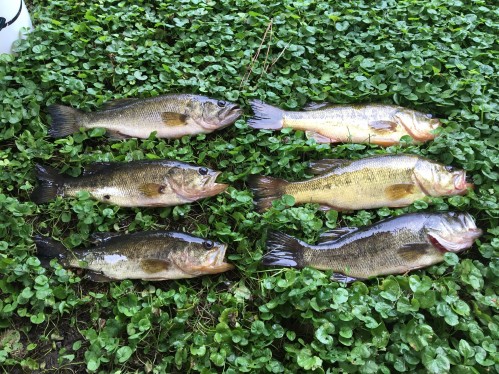
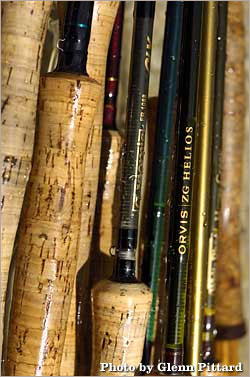 figure out what is the best outfit for you. I was not so lucky when I got into the sport in the mid ‘90’s. All I had was my dad. He gave me an old fly rod with and old automatic fly reel. I would later buy a really cheap combo from Academy and became a really nuisance to the bluegill population in the drainage canal at the end of my street. Since then I have learned most of the terminology in fly fishing when it comes to the “hardware”. I’ll share most of that now to take the mystery out of choosing your first set up.
figure out what is the best outfit for you. I was not so lucky when I got into the sport in the mid ‘90’s. All I had was my dad. He gave me an old fly rod with and old automatic fly reel. I would later buy a really cheap combo from Academy and became a really nuisance to the bluegill population in the drainage canal at the end of my street. Since then I have learned most of the terminology in fly fishing when it comes to the “hardware”. I’ll share most of that now to take the mystery out of choosing your first set up.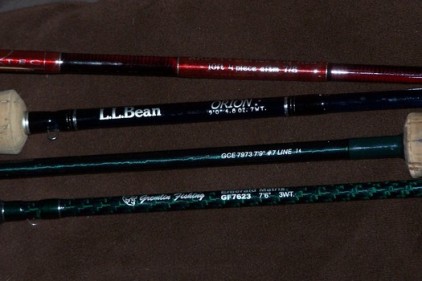 fishing here in south Louisiana an 8 and a half or 9 ft rod is all you need. You’re also going to find rods come in 1, 2, 3, or 4 pieces. You’ll find more 3 or 4 piece rods locally. This choice is all personal preference.
fishing here in south Louisiana an 8 and a half or 9 ft rod is all you need. You’re also going to find rods come in 1, 2, 3, or 4 pieces. You’ll find more 3 or 4 piece rods locally. This choice is all personal preference. 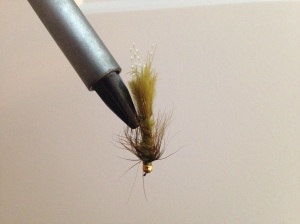 fished. Down here it can imitate large nymphs, baitfish, leeches,drowning terrestrial insects, worms, crawfish, or shrimp. You can find them from size 14 to 2. I have been known to tie them on a 2/0 pike hook with a weighted cone head, think bullet weight, and fish it like a texas rigged worm for bass. They are readily found at most fly shops in black, olive, and tan. If you know any fly tyers, then the color combinations are only limited by the colors of marabou and chenille available. Fish it with a steady retrieve or under a strike indicator. The “magnum” ones work for bass and the small to medium sizes will catch bream and sacalait.
fished. Down here it can imitate large nymphs, baitfish, leeches,drowning terrestrial insects, worms, crawfish, or shrimp. You can find them from size 14 to 2. I have been known to tie them on a 2/0 pike hook with a weighted cone head, think bullet weight, and fish it like a texas rigged worm for bass. They are readily found at most fly shops in black, olive, and tan. If you know any fly tyers, then the color combinations are only limited by the colors of marabou and chenille available. Fish it with a steady retrieve or under a strike indicator. The “magnum” ones work for bass and the small to medium sizes will catch bream and sacalait.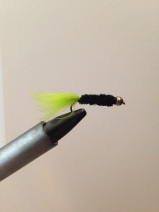 woolly bugger without the hackle. If you’ve ever fished a marabou jig on ultralight
woolly bugger without the hackle. If you’ve ever fished a marabou jig on ultralight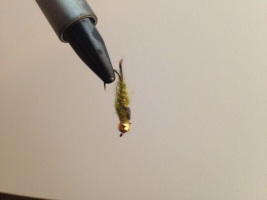 tail because it can be tied in a variety of colors. You can find them in black, brown, or olive and in bead-head and standard(nonbead-head). They are typically tied in sizes 10 to 16. I prefer the 2 in the middle, sizes 12 and 14. Remember I said they are versatile, they imitate a variety of aquatic life; scuds, sow bugs, mayfly nymphs, caddis larvae, damselfly larvae, dragonfly larvae, and stonefly larvae. I fish them year round. Because of how small they are you will catch a bunch of fish and many of them small, but when fished in the cooler months you will catch some of the bigger bream on them. Fish them with or without a strike indicator but fish them slow, the things they imitate don’t move very fast.
tail because it can be tied in a variety of colors. You can find them in black, brown, or olive and in bead-head and standard(nonbead-head). They are typically tied in sizes 10 to 16. I prefer the 2 in the middle, sizes 12 and 14. Remember I said they are versatile, they imitate a variety of aquatic life; scuds, sow bugs, mayfly nymphs, caddis larvae, damselfly larvae, dragonfly larvae, and stonefly larvae. I fish them year round. Because of how small they are you will catch a bunch of fish and many of them small, but when fished in the cooler months you will catch some of the bigger bream on them. Fish them with or without a strike indicator but fish them slow, the things they imitate don’t move very fast. 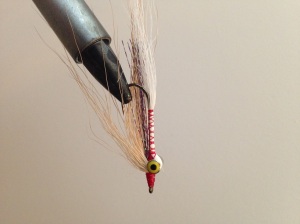 Pennsylvania fly shop owner and guide, in 1987. It was evolved from traditional bucktail streamers for smallmouth bass on the Susquehanna River. Noted fly fishing writer Lefty Kreh claims to have caught over 87 species of game fish on Clouser minnows, he is also the one who gave them their name in 1989. This fly a baitfish imitation that ranges in size from 10 up to 1/0. They come in a myriad of color combinations with the “belly” traditionally being white. The lead eyes are are tied on so the fly rides hook point up so it can be relatively weedless. Fish them in either fresh or saltwater, the work just as well for specks and redfish as they do for bass.
Pennsylvania fly shop owner and guide, in 1987. It was evolved from traditional bucktail streamers for smallmouth bass on the Susquehanna River. Noted fly fishing writer Lefty Kreh claims to have caught over 87 species of game fish on Clouser minnows, he is also the one who gave them their name in 1989. This fly a baitfish imitation that ranges in size from 10 up to 1/0. They come in a myriad of color combinations with the “belly” traditionally being white. The lead eyes are are tied on so the fly rides hook point up so it can be relatively weedless. Fish them in either fresh or saltwater, the work just as well for specks and redfish as they do for bass.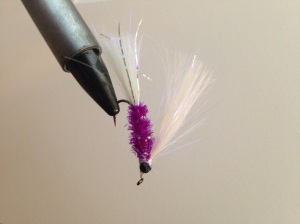 body of chenille with a wing and tail of fur. I personally tie these from a size 12 and 10 for sacalait up to a size 4 for bass. Fish them with or without a strike indicator. This is another of those flies that can be a bit of a pain to find. The only place I have found them is at the Green Trout in Baton Rouge, and even then it’s in limited quantities. That is the reason I learned how to tie them myself. I tie them in all sorts of colors: black and chartreuse, black and pink, chartreuse and white, pink and white, pink and chartreuse, purple and white. If you can’t find them at the fly shops in the area, then ask your local fly tyer or I might be convinced to make some. If you are a fly tyer go to Onthevise.com and seach “crappie candy.”
body of chenille with a wing and tail of fur. I personally tie these from a size 12 and 10 for sacalait up to a size 4 for bass. Fish them with or without a strike indicator. This is another of those flies that can be a bit of a pain to find. The only place I have found them is at the Green Trout in Baton Rouge, and even then it’s in limited quantities. That is the reason I learned how to tie them myself. I tie them in all sorts of colors: black and chartreuse, black and pink, chartreuse and white, pink and white, pink and chartreuse, purple and white. If you can’t find them at the fly shops in the area, then ask your local fly tyer or I might be convinced to make some. If you are a fly tyer go to Onthevise.com and seach “crappie candy.”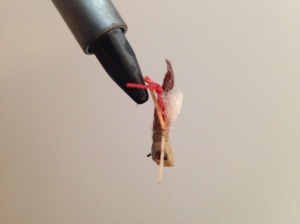 and foam grasshoppers. I’m putting these together because they are both made of foam and float, but have a different silhouette. You can find foam spiders at Academy and sometimes Walmart from Bett’s. I get my foam grasshoppers from Bass Pro. The bluegill love them! In the spring and summer fish them close to the bank and have fun catching fish. They don’t just work on bluegill, the also work on bass. My all-time best bass was caught on a size 10 foam grasshopper. The strike on that bass looked like a small bluegill eating the fly but ended up being a 5 and a half pound bass. They work!
and foam grasshoppers. I’m putting these together because they are both made of foam and float, but have a different silhouette. You can find foam spiders at Academy and sometimes Walmart from Bett’s. I get my foam grasshoppers from Bass Pro. The bluegill love them! In the spring and summer fish them close to the bank and have fun catching fish. They don’t just work on bluegill, the also work on bass. My all-time best bass was caught on a size 10 foam grasshopper. The strike on that bass looked like a small bluegill eating the fly but ended up being a 5 and a half pound bass. They work!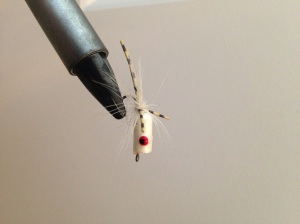 dozen in the spring and summer. In fact, I have 3 with the primer coat drying right now waiting for paint. Accardo used to be the name for popping bug. Unfortunately Accardo was bought by Bett’s a few years ago so now just about all the popping bugs you will find are made by Bett’s, but they use some of the old Accardo paint patterns. You can find small ones for bluegill, medium ones for bass, and big ones for redfish.
dozen in the spring and summer. In fact, I have 3 with the primer coat drying right now waiting for paint. Accardo used to be the name for popping bug. Unfortunately Accardo was bought by Bett’s a few years ago so now just about all the popping bugs you will find are made by Bett’s, but they use some of the old Accardo paint patterns. You can find small ones for bluegill, medium ones for bass, and big ones for redfish. 